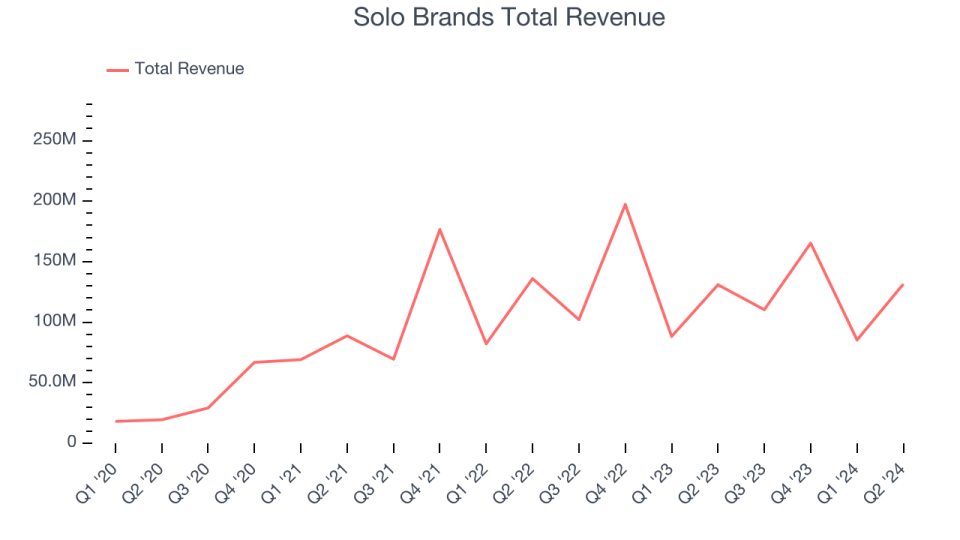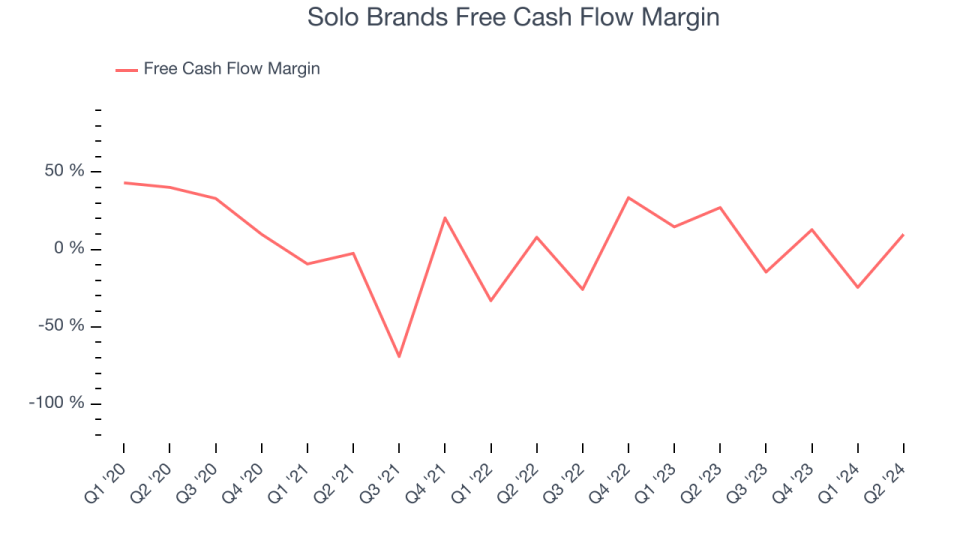Solo Brands's (NYSE:DTC) Q2: Beats On Revenue But Stock Drops

Outdoor lifestyle and recreational products company Solo Brands (NYSE:DTC) reported Q2 CY2024 results beating Wall Street analysts' expectations , with revenue flat year on year at $131.6 million. On the other hand, the company's full-year revenue guidance of $480 million at the midpoint came in 3.9% below analysts' estimates. It made a non-GAAP profit of $0.04 per share, down from its profit of $0.22 per share in the same quarter last year.
Is now the time to buy Solo Brands? Find out in our full research report.
Solo Brands (DTC) Q2 CY2024 Highlights:
Revenue: $131.6 million vs analyst estimates of $128.5 million (2.4% beat)
EPS (non-GAAP): $0.04 vs analyst estimates of $0.13 (-$0.09 miss)
The company dropped its revenue guidance for the full year from $500 million to $480 million at the midpoint, a 4% decrease
Gross Margin (GAAP): 62.8%, in line with the same quarter last year
EBITDA Margin: 11.7%, down from 19.1% in the same quarter last year
Free Cash Flow of $12.84 million is up from -$20.91 million in the previous quarter
Market Capitalization: $117.6 million
Started through a Kickstarter campaign, Solo Brands (NYSE:DTC) is a provider of outdoor and recreational products.
Leisure Products
Leisure products cover a wide range of goods in the consumer discretionary sector. Maintaining a strong brand is key to success, and those who differentiate themselves will enjoy customer loyalty and pricing power while those who don’t may find themselves in precarious positions due to the non-essential nature of their offerings.
Sales Growth
A company’s long-term performance can give signals about its business quality. Even a bad business can shine for one or two quarters, but a top-tier one tends to grow for years. Over the last four years, Solo Brands grew its sales at an incredible 55.1% compounded annual growth rate. This shows it expanded quickly, a useful starting point for our analysis.

Long-term growth is the most important, but within consumer discretionary, product cycles are short and revenue can be hit-driven due to rapidly changing trends and consumer preferences. Solo Brands's recent history shows its demand slowed significantly as its annualized revenue growth of 3% over the last two years is well below its four-year trend.
We can better understand the company's revenue dynamics by analyzing its most important segments, Direct-to-Consumer and Wholesale, which are 75.1% and 24.9% of revenue. Over the last two years, Solo Brands's Direct-to-Consumer revenue (direct sales to customers) averaged 2.1% year-on-year declines. On the other hand, its Wholesale revenue (sales to retailers) averaged 58.9% growth.
This quarter, Solo Brands's $131.6 million of revenue was flat year on year but beat Wall Street's estimates by 2.4%. Looking ahead, Wall Street expects sales to grow 3.4% over the next 12 months, an acceleration from this quarter.
Here at StockStory, we certainly understand the potential of thematic investing. Diverse winners from Microsoft (MSFT) to Alphabet (GOOG), Coca-Cola (KO) to Monster Beverage (MNST) could all have been identified as promising growth stories with a megatrend driving the growth. So, in that spirit, we’ve identified a relatively under-the-radar profitable growth stock benefitting from the rise of AI, available to you FREE via this link.
Cash Is King
If you've followed StockStory for a while, you know we emphasize free cash flow. Why, you ask? We believe that in the end, cash is king, and you can't use accounting profits to pay the bills.
Solo Brands has shown mediocre cash profitability over the last two years, giving the company limited opportunities to return capital to shareholders. Its free cash flow margin averaged 8.4%, subpar for a consumer discretionary business.

Solo Brands's free cash flow clocked in at $12.84 million in Q2, equivalent to a 9.8% margin. The company's cash profitability regressed as it was 17.3 percentage points lower than in the same quarter last year, but it's still above its two-year average. We wouldn't read too much into this quarter's decline because investment needs can be seasonal, leading to short-term swings. Long-term trends trump temporary fluctuations.
Key Takeaways from Solo Brands's Q2 Results
It was good to see Solo Brands beat analysts' revenue expectations this quarter. On the other hand, its full-year revenue guidance missed and its EPS fell short of Wall Street's estimates. Overall, this was a bad quarter for Solo Brands. The stock traded down 9% to $1.82 immediately after reporting.
Solo Brands may have had a tough quarter, but does that actually create an opportunity to invest right now? When making that decision, it's important to consider its valuation, business qualities, as well as what has happened in the latest quarter. We cover that in our actionable full research report which you can read here, it's free.